
Emballonuridae is a family of microbats, many of which are referred to as sac-winged or sheath-tailed bats. They are widely distributed in tropical and subtropical regions around the world. The earliest fossil records are from the Eocene.

The hairy-legged vampire bat is one of three extant species of vampire bats. It mainly feeds on the blood of wild birds, but can also feed both on domestic birds and humans. This vampire bat lives mainly in tropical and subtropical forestlands of South America, Central America, and southern Mexico. It is the sole member of the genus Diphylla.

The greater dog-like bat is a bat species found from southern Mexico through Brazil and Peru.

The tricolored big-eared bat is a bat species from South and Central America.
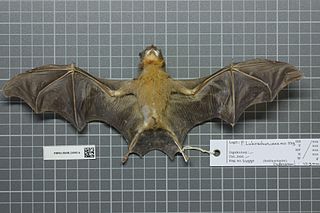
The yellow-throated big-eared bat or orange-throated bat(Lampronycteris brachyotis) is a species of bat that ranges from southern Mexico to Brazil. It is the only species within the genus Lampronycteris. A frugivore and insectivore, it is found in lowland forest up to an elevation of 700 m. Its activity is greatest in the first two hours after sunset, and peaks again after midnight.

The common big-eared bat is a bat species from South and Central America. It is a member of the family Phyllostomidae.

The gray sac-winged bat is a species in the family Emballonuridae which comprises the 51 species of sac-winged bats. It is found in Mexico from Baja California Sur and Sonora to Guatemala, El Salvador, Honduras, Nicaragua, Costa Rica and northern Colombia, at elevations up to 1,500 metres (4,900 ft).

Genoways's yellow bat is a species of vesper bat found only in Mexico. It is threatened by habitat loss. Due to its imperiled status, it is identified by the Alliance for Zero Extinction as a species in danger of imminent extinction.
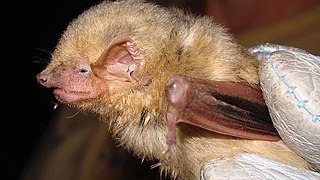
The western yellow bat is a species of vesper bat found in Mexico and the southwestern United States. This species roosts in trees such as Populus fremontii, Platanus wrightii, and Quercus arizonica. If available, the western yellow bat will use the dead fronds that encircle palm trees as a roosting site.

The western small-footed bat, also known as the western small-footed myotis, is a species of vesper bat native to North America.

Findley's myotis is a species of vesper bat. It is found only on the Tres Marías Islands off the west coast of Mexico.

The flat-headed myotis is a species of vesper bat. It is endemic to Mexico where it is found in certain montane forests in the Sierra Madre Oriental in the northeast of the country. Once thought to be extinct, this bat was rediscovered in 2004 by Joaquín Arroyo-Cabrales and colleagues. The species is now classified as endangered by the IUCN.
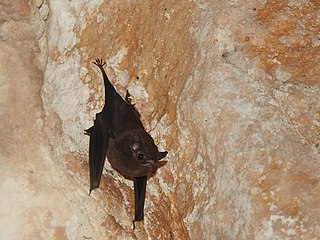
Thomas's sac-winged bat is a species of sac-winged bat in the family Emballonuridae. It is found in Belize, Guatemala, and Mexico.
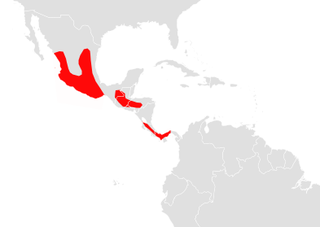
The Aztec fruit-eating bat is a species of bat in the family Phyllostomidae.

The gray short-tailed bat, or Hahn's short-tailed bat, is a species of bat in the family Phyllostomidae native to Mexico and Central America.

The velvety fruit-eating bat, also known as Hart's little fruit bat, is a species of bat in the family Phyllostomidae. It is the only species within the genus Enchisthenes. It is found in Central America, Mexico, the United States, and northern South America.

Centronycteris is a genus of sac-winged bats. It contains two species:
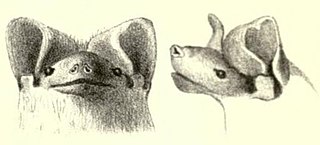
The Aztec mastiff bat is a species of bat in the family Molossidae. It is insectivorous.

The Cozumelan golden bat is a bat species found in Mexico, Guatemala, Belize, Honduras, Nicaragua, Costa Rica, Panama and Colombia. At one time, this species was considered to be a subspecies of the golden bat. Little is known about the biology of this bat, but it has a wide range, no particular threats have been identified, and the population seems steady, so the International Union for Conservation of Nature has assessed its conservation status as being of "the least concern".





















